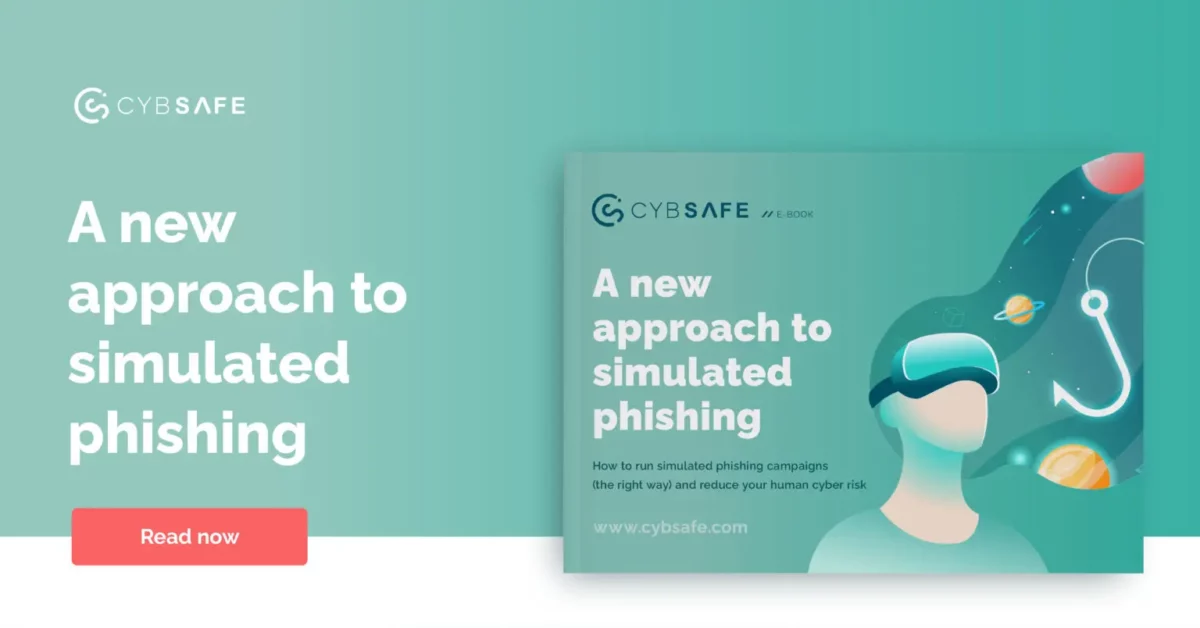CybSafe’s CEO and founder Oz Alashe unpacks why your colleagues keep missing the point on behavioral risk – and what to do about it

Imagine receiving an urgent email from your CEO—but it's not them but a scammer.
Hold on, it’s a classic CEO impersonation—a sophisticated form of executive email fraud now putting your company at risk.
Welcome to the world of executive phishing, where the stakes are high and the tactics, sophisticated, in what's becoming an increasingly common type of phishing attack.
Phishing is simple, but the consequences are pretty serious.
According to IBM’s Cost of a Data Breach Report 2023, it was the second most common cause of data breach in the US in 2023, and averaged $4.45 million in breach costs for companies, a 15% increase over 3 years.
Stats like that make it clear why it makes sense to help people recognize phishing scams. But what about executive phishing?

Executive phishing is along the same lines, but the scammers are a company's high-level staff, such as CEOs. In other words, they use the sway of the biggest fish to get a bite.
Impersonating the general rather than a footsoldier may seem like a tall order for cybercriminals. But they know exactly what they’re doing.
And, as with so many parts of cybercrime, they’re banking on the human element.
Understanding the mechanics of an executive phishing attack is crucial for building a resilient defense strategy for your organization’s leaders.
Picture this: it's November 2022, and a group of crafty scammers, masquerading as healthcare providers, manage to swindle insurance employees into rerouting hefty sums designated for Medicare and Medicaid.
The damage? A cool $4.7 million vanishes. This isn't a script for a heist movie—it happened, and it underscores the cunning reality of executive phishing.
Just goes to show, even the most buttoned-up institutions aren't immune to these digital con artists.

Alright, let’s start with executive phishing.
It’s no secret that an organization’s leadership commands a certain level of influence. It stands to reason, then, that people want to keep leadership happy. They want to do what their boss asks of them—even if the request is a bit weird.
And this people-pleasing tendency can make people panic or put haste ahead of caution when they are dealing with the C-suite.
For example, Matt gets an email from his CEO asking him to transfer urgent funds. Usually he’d ask for more details and follow standard procedures before moving money around, but this is the Big Cheese telling him to do something. So he’d better get on and do it.
That’s exactly what the scammer’s counting on with their phishing attack. And it can happen to anyone.
Matt authorizes the payment. Unbeknownst to him, the money has landed in the cyber criminal’s bank account.
To make matters worse, incidents like this can go undiscovered for months. Data breaches involving stolen credentials take an average of 243 days to identify and another 84 days to contain. Scary.
So, that’s executive phishing. But what about whaling?
This is when a scammer targets an executive directly. Rather than trying to catch a small fish by using a CEO persona—like what happened to Matt—whaling is about catching the big and powerful figures in an organization.
The executives are subject to the exact same process—the scammer poses as someone known to the recipient and asks for sensitive data or for money.
A senior leader may have bags of knowledge and experience and skills—but they, too, are human. And that means they’re at risk of failing to scrutinize the request before complying and falling into the trap.
Executive phishing often sees scammers casting a wide net within a company, leveraging the clout of high-flyers to snag their catch.
On the flip side, whaling is the big game hunting of the cybercrime savannah, where the scammers set their sights squarely on the C-suite's elite.
Grasping the subtle differences between these threats isn't just smart—it's crucial armor in fortifying your company's defenses.
Want to make sure your security strategy covers executive phishing and whaling? Fear not, because we’re about to give you some examples, some prevention tips, and some advice on what to do if you get caught.

Sometimes phishing emails are complex, and sometimes their effectiveness is in their simplicity. Either way, knowing what they are and why they are effective is a good starting point.
Scammers often meticulously research the formatting of their emails to make them as believable as possible, a common tactic in phishing attacks. Within that email, typical phishing examples include:

There are a few simple ways to mitigate the risk of falling victim to executive phishing, which we’ve compiled for you here in a handy list . . . because we’re nice like that.
To sum up, to fortify your company against the cunning depths of executive phishing, anchor your defense with multi-factor authentication and good passowrd hygiene—it's your cybersecurity life jacket. Combine this with up-to-the-minute software defenses, as current as your team's professional skills.
But don't rely on tech alone; dive into the human aspect. A robust human risk management platform can turn your crew into a phalanx of informed guardians.
Through continuous security awareness training, realistic phishing simulations, and insightful behavioral metrics, you cultivate a workplace that not only detects threats but instinctively repels them.
It's about fostering a security-first culture within your organization, from the junior staff to the executive boardroom, where every member is an active participant in safeguarding the enterprise.
Spotting a phishing scheme in the wild is just the opening move; the endgame is in the swift strike of the report button.
The instant those fishy vibes hit, your cybersecurity team should be on speed dial. But, awareness alone won't keep your digital domain safe.
It's about drilling that muscle memory with regular cyber fire drills and immersive security boot camps, sharpening instincts until they're razor-edged.
When the pressure's on, it's the rehearsed reflexes that count. Enabling a culture that champions vigilance and swift action is what sets apart a secure fortress from an open gate.

What are the primary tactics used in executive phishing scams?
Executive phishing scams primarily utilize email impersonation, where scammers pose as high-level executives to manipulate employees into revealing sensitive information or transferring funds. These attacks often rely on the authority and urgency implied by a senior executive’s identity, exploiting the human tendency to respond quickly to perceived high-stakes requests from leadership.
How does executive phishing differ from traditional phishing attacks?
While traditional phishing attacks might target a wide range of individuals within an organization with generic requests, executive phishing specifically impersonates senior executives to exploit the trust and authority those positions hold. These attacks are often more targeted and sophisticated, using tailored communication that appears more credible and urgent due to the supposed high-ranking sender.
What are some common signs of an executive phishing attempt?
Common signs include unexpected requests for urgent action, such as transferring funds or providing confidential information, inconsistencies in the email address or communication style of the supposed sender, and a lack of usual verification processes. Often, these emails create a sense of urgency or pressure to bypass normal security protocols.
How can organizations protect themselves against executive phishing?
Organizations can bolster their defenses against executive phishing through a multi-layered approach. This includes conducting regular security awareness training for employees to recognize and respond appropriately to phishing attempts. Additionally, implementing phishing simulations can help employees gain practical experience in identifying and handling phishing emails in a controlled environment. Investing in human risk management platforms is also crucial; these platforms can provide comprehensive insights into employee behavior and vulnerabilities, allowing for targeted interventions and enhanced overall security posture. These strategies, combined with strong verification processes for financial transactions and sensitive requests, and the use of advanced email security solutions, form a robust defense against executive phishing attacks.
What steps should be taken if someone falls victim to an executive phishing scam?
Immediate actions include reporting the incident to the organization’s IT or cybersecurity team, changing any compromised passwords, and monitoring for unusual account activity. It’s also important to inform financial institutions if any unauthorized transactions were made. Conducting a thorough investigation to understand the breach’s extent and implementing measures to prevent future incidents is essential.